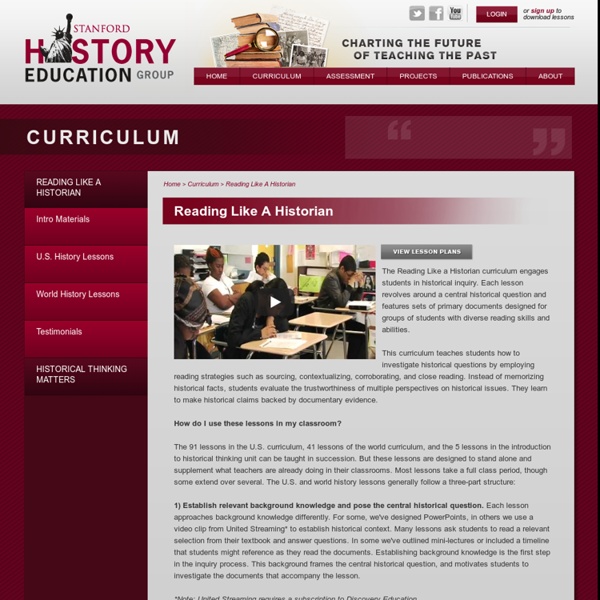Why Study History - QHTA
History is about change. It is the subject that contributes the most to the broadening out of the imagination. One of the purposes of a study of history is to help students transcend their own immediate experience and gain an understanding about how humanity has evolved and developed. It is ironic that when there is constant media comment on the need for workers of the future to be capable of adapting to change, that the academic study of change provided through the history curriculum is dismissed. History teaches critical thinking, something we all need plenty of today. It looks at people over times past and present in different societies, noticing and explaining their attitudes, beliefs and behaviours, and interpreting their reactions to the various pressures, conditions and events that induce change.
National Archives: Teaching With Documents
When we ask students to work with and learn from primary sources, we transform them into historians. Rather than passively receiving information from a teacher or textbook, students engage in the activities of historians — making sense of the stories, events and ideas of the past through document analysis. Document Analysis Document analysis is the first step in working with primary sources. Teach your students to think through primary source documents for contextual understanding and to extract information to make informed judgments.
9. Final Draft
Once you have received feedback on your draft from your teacher, you only need to improve your essay for final submission. Fix up any errors, add any extra information and take the time to improve your writing style. Great writing shows sophistication, so make sure you use academic language when you write your essays. An essay needs to be a continuous series of well-written, correctly spelled English sentences, formed into coherent paragraphs and carry a succinct argument. Here are some final points to consider: Avoid conversational or colloquial language Avoid personal pronouns: do not use "I" and "my" when you write Use language that is appropriate for scholarly work: it should be clear, succinct, and objective.
Geography Awareness Week 2017: The Geography of Civil Rights Movements
This week, Geography Awareness Week celebrates 30 years of geo goodness. Established in 1987, the week is designed to promote geography and highlight the relevance of a geographic education in preparing citizens to understand and debate pressing social and environmental issues and problems. This year’s theme focuses on the Geography of Civil Rights Movements. A recent American Association of Geographers press release suggests that a “civil rights-themed Geography Awareness Week can be an important moment, especially during these turbulent political times, to come to terms with the nation’s unreconciled legacies of oppression and domination.” The AAG goes on: So what can that look like?
Corroboration
When you are analysing a source, it is helpful to compare what information it provides when compared with other sources. This helps you to more successfully evaluate your sources, especially in regards to their accuracy. In order to identify information that is agreed upon by two different sources, following these steps: Read the first source and summarise the key points of historical information it provides. Using direct and indirect quotes helps with this. Read the second source and summarise the key points of historical information it provides.
Social Studies Central
Featured Product: Evidence Analysis Window Frame We often ask students to analyze evidence and to think historically. But these are skills that often need scaffolding.
Relevance
As an evaluation skill, relevance is one way that you can prove that a source is valuable. Relevance is the easiest of the evaluation skills to use and should be relied upon if you cannot say anything else when evaluating the source. Relevance is a statement about how useful or helpful a particular source is in provide information about your topic. If a source is helpful in providing any information about your topic, it is considered to be a relevant source. You can also argue that a source is relevant if you found any of the following during your analysis of the source: It provided explicit or implicit information about your historical topic.
Teaching with the Library of Congress
Stop-action photography has become an integral part of our lives. It allows us to watch the beauty of a dancer, the grace of an athlete or the motion of an animal one frame at a time. It is hard to believe that until Edweard Muybridge began his study of animal locomotion with photography in the late 19th century, we were limited to only what the eye could see or what was in a single photograph. In celebration of Muybridge’s birthday, the Library of Congress has uploaded a number of Muybridge’s Animal Locomotion images from its collections into Flickr. The horse in motion, illus. by Muybridge.
Accuracy
Accuracy is a source evaluation skill where you are asked to come to a conclusion about the correctness of the information provided by a source. Accuracy is the assessment that the information provided in a source is likely to be correct. Since it is almost impossible to be 100% certain of a source’s accuracy, your answer needs to talk in terms of the ‘degree of potential accuracy’: For example: Extremely - Very – Somewhat – Rarely – Not very



